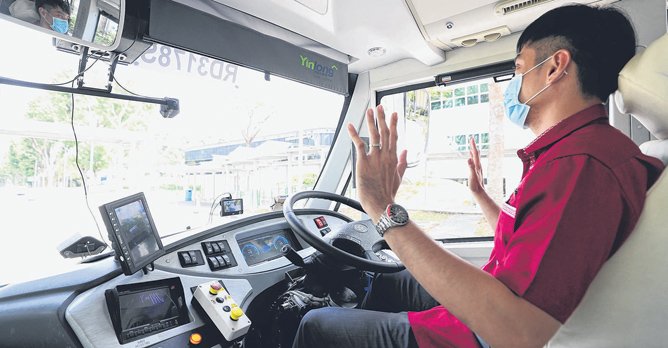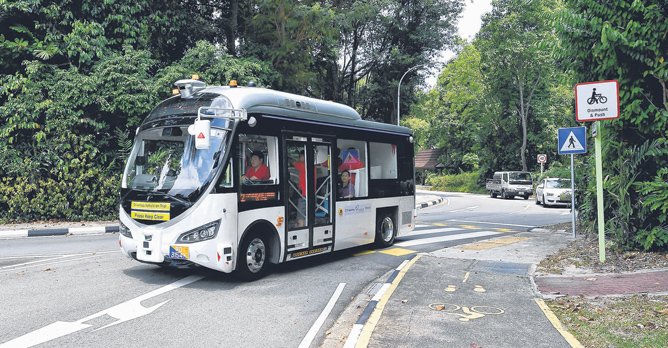Pay-to-ride driverless buses begin operations in two areas of Singapore
27 Jan 2021|1,164 views
Commuters can now take driverless buses in two areas of Singapore for a small fee, in the first such trial since the Republic began experimenting with autonomous vehicles on the roads in 2015.
The new services, headed by ST Engineering, are operated by SMRT and SBS Transit, the two largest bus operators here.

The aim is to bring the technology a step closer to becoming a part of Singapore's mainstream public transport system.
The trial, which will continue until 30 April 2021 will provide real-world data on what is needed for these buses to be rolled out commercially in both local and overseas contexts. Companies in the region are already expressing interest in the buses' viability in their countries, said Mr. Vincent Chong, Group President and Chief Executive Officer of ST Engineering.
The pilot comes after the KPMG autonomous vehicle readiness index last year ranked Singapore first in the world. Those involved said they were committed to maintaining Singapore's edge in the burgeoning area, which could reap economic returns for the country once it takes off.

He added that driverless buses still have some way to go to be integrated into the system - at least five years, according to industry watchers - but that it is a very exciting technology that could possibly be applied to Housing and Development Board towns in the future. A handful of trials of driverless buses have been conducted in the past five years, although they were not fee-paying.
One of the most high-profile was a three-month operation on Sentosa in 2019 that ferried more than 6,000 members of the public - free of charge - without any incident.

In the Singapore Science Park 2 part of the trial, the driver switches from automatic to manual mode in West Coast Highway and Pasir Panjang Road between the park and Haw Par Villa MRT station, in accordance with the LTA's geographical restrictions on where these autonomous vehicles can operate.
For now, buses in the new pilot are operating on an on-demand basis, where commuters make a booking on an app, pay their fares using credit or debit cards, and board the bus when it makes its loop during specified time periods. They are also able to view where the bus is on the app to better plan their trips.
Mr. Harry Lim, 56, who works in a smart innovation lab in Singapore Science Park, said he was persuaded to use the service as a driver is always present. He has taken the service about three times in the past week, and said journeys have all been smooth.
"For me, it's about getting point to point," he said. "The previous bus service is quite irregular, so this helps me plan my trip better." Mr. Ong said drivers will remain essential to the operation of autonomous vehicles even when these do take off, although their job scope will change.
For instance, a driver might have to commandeer the vehicle should there be an accident on the road, or if someone in a wheelchair needs help boarding the bus. He added, "If this becomes successful, it will greatly reduce our reliance on foreign manpower and physical manpower. This is an area of public transport where we cannot hire enough people."
The pilots are organised by an Alliance for Action on Robotics - which brings together transport stakeholders from operators to technology providers - set up by the Government to promote the use of robotics in land transport and cleaning. It falls under the Emerging Stronger Taskforce created last year to chart Singapore's recovery and create jobs that will be sustainable after the pandemic.
Commuters can now take driverless buses in two areas of Singapore for a small fee, in the first such trial since the Republic began experimenting with autonomous vehicles on the roads in 2015.
The new services, headed by ST Engineering, are operated by SMRT and SBS Transit, the two largest bus operators here.

The aim is to bring the technology a step closer to becoming a part of Singapore's mainstream public transport system.
The trial, which will continue until 30 April 2021 will provide real-world data on what is needed for these buses to be rolled out commercially in both local and overseas contexts. Companies in the region are already expressing interest in the buses' viability in their countries, said Mr. Vincent Chong, Group President and Chief Executive Officer of ST Engineering.
The pilot comes after the KPMG autonomous vehicle readiness index last year ranked Singapore first in the world. Those involved said they were committed to maintaining Singapore's edge in the burgeoning area, which could reap economic returns for the country once it takes off.

He added that driverless buses still have some way to go to be integrated into the system - at least five years, according to industry watchers - but that it is a very exciting technology that could possibly be applied to Housing and Development Board towns in the future. A handful of trials of driverless buses have been conducted in the past five years, although they were not fee-paying.
One of the most high-profile was a three-month operation on Sentosa in 2019 that ferried more than 6,000 members of the public - free of charge - without any incident.

In the Singapore Science Park 2 part of the trial, the driver switches from automatic to manual mode in West Coast Highway and Pasir Panjang Road between the park and Haw Par Villa MRT station, in accordance with the LTA's geographical restrictions on where these autonomous vehicles can operate.
For now, buses in the new pilot are operating on an on-demand basis, where commuters make a booking on an app, pay their fares using credit or debit cards, and board the bus when it makes its loop during specified time periods. They are also able to view where the bus is on the app to better plan their trips.
Mr. Harry Lim, 56, who works in a smart innovation lab in Singapore Science Park, said he was persuaded to use the service as a driver is always present. He has taken the service about three times in the past week, and said journeys have all been smooth.
"For me, it's about getting point to point," he said. "The previous bus service is quite irregular, so this helps me plan my trip better." Mr. Ong said drivers will remain essential to the operation of autonomous vehicles even when these do take off, although their job scope will change.
For instance, a driver might have to commandeer the vehicle should there be an accident on the road, or if someone in a wheelchair needs help boarding the bus. He added, "If this becomes successful, it will greatly reduce our reliance on foreign manpower and physical manpower. This is an area of public transport where we cannot hire enough people."
The pilots are organised by an Alliance for Action on Robotics - which brings together transport stakeholders from operators to technology providers - set up by the Government to promote the use of robotics in land transport and cleaning. It falls under the Emerging Stronger Taskforce created last year to chart Singapore's recovery and create jobs that will be sustainable after the pandemic.
Latest COE Prices
August 2025 | 2nd BIDDING
NEXT TENDER: 03 Sep 2025
CAT A$104,524
CAT B$124,400
CAT C$72,190
CAT E$125,001
View Full Results Thank You For Your Subscription.




















